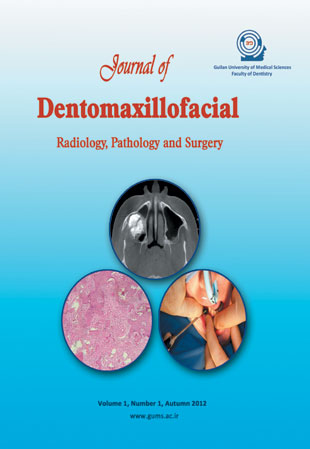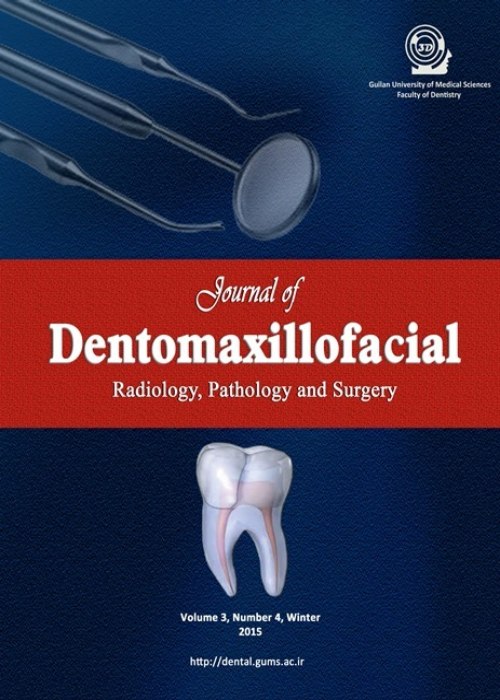فهرست مطالب

Journal of Dentomaxillofacil Radiology, Pathology and Surgery
Volume:1 Issue: 1, autumn 2012
- تاریخ انتشار: 1391/10/11
- تعداد عناوین: 8
-
-
Page 1IntroductionDue to the complexity of facial asy-mmetry, the diagnosis of different aspects of asymmetry via conventional radiographs is not precise. In this study, we investigated findings of facial asymmetry by using cone- beam computed tomography (CBCT) images.Materials And MethodsIn this descriptive study, we evaluated CBCT findings of 18 patients i.e. a group of 14 females and 4 males having a mean age of 22.7 years who referred to a maxillofacial radiology clinic due to facial asymmetry from 2010 to 2011. Findings of asymmetry were inves-tigated using axial, coronal and sagittal views.ResultsAs detected in axial view, 9 of 18 patients had yaw in the maxilla. Approximately 14 and 11 patients had yaw in the mandible and zygoma respectively. Differences were observed between the medio-lateral dimensions of the condylar heads in 7 patients. We also detected the cervical spine deviation in 9 cases. Moreover, a difference in the antero-posterior position of the glenoid fossa in 10 patients was observed. In coronal view, “roll” i.e “cant” in the maxilla, mandible and orbital cavities was found in 14, 12 and 1 patient respectively. Differences in the condylar neck height in 9 patients and in the level of the glenoid fossa in 11 patients were observed.ConclusionCBCT is effective in evaluating the details of asymmetry and its effects on facial structures. In addition, three-dimensional approaches for the analysis of asymmetry transform it from a simple and predictable phenomenon into an incredibly complicated process. Pursuing orthodontic treatment plan without considering these complexi-ties and details is not successful.Keywords: Cone, beam computed tomography •Facial asymmetry •Findings
-
Page 10IntroductionFew studies on benign soft tissue tumors of oral cavity have been conducted in an Iranian population. The purpose of this study was to evaluate the prevalence of the benign soft tissue tumors of the oral cavity in three central pathology centers of Rasht, Iran.Materials And MethodsIn this retrospective study, all benign soft tissue tumors of the oral cavity, were retrieved from Razi, Afrah and Poursina Hospital Pathology Laboratories during 2000 to 2008, and demographic data for each case was recorded.ResultsFrom 433(18.4%) benign soft tissue tumors, 395(91.2%) reactive and 38 neoplastic lesions (8.8%) were found. The mean age of the patients was 41.89±18.13 years. Females constituted 65.4% of the population suffering from lesions. Gingiva was the most common site of tumors (53.1%). The most common lesion in the reactive group was pyogenic granuloma (32.4%, n=128). Hemangioma (39.5%, n=15) and lipoma (36.8%, n=14) were highly noticeable in the neoplastic group respectively.There was no significant correlation between gender and age, and the type of the tumor (Neoplastic or reactive) except the site of involvement. However, a significant correlation existed between the site of lesion and the type of tumor.ConclusionThe most common benign soft tissue tumor was pyogenic granuloma followed by irritation fibroma. Most of the reactive lesions were found in gingiva.Keywords: Mouth •Soft tissue neoplasm •Granuloma, pyogenic •Fibroma
-
Page 15Introduction
According to the prevalence of sore mouth, its outcome and possible role of anemia in its etiology and some contradictions in this theory, our study was performed to evaluate the role of iron deficiency anemia as a etiological factor for sore mouth.
Materials And MethodsThis historical cohort study was performed on 40 cases, including 20 anemic patients as the experimental group and 20 healthy individuals as the control group with similarity in socio economical, sex and age factors. Oral examination was carried out in two groups to evaluate soremouth presentations including atrophic glossitis, recurrent oral ulceration, pale oral mucosa, tongue burning sensation, glossodynia and angular cheilitis. Data was analyzed by chi-square test. Attributable risk (AR) and related risk (RR) were calculated.
ResultsOut of 40 studied cases, sore mouth manifestations were found in (45%) of individuals in case and (5%) control groups (p<0.005). Regarding the anemic patients, RR and AR of sore mouth were 9 and 40% respectively. The most prevalent manifestations of sore mouth were atrophic glossitis, recurrent oral ulceration, pale oral mucosa, tongue burning sensation, glossodynia and angular cheilitis.
ConclusionAccording to this study, it seems iron deficiency anemia has a significant role in sore mouth incidence. Evaluation of anemia treatment effect on sore mouth elimination is recommended.
Keywords: Anemia, Oral ulcer, Cheilitis, Mucositis -
Page 19IntroductionTo compare the effects of 0.05% sodium fluoride (NaF) mouthrinse, GC Tooth Mousse and GC MI Paste Plus on white spot formation inhibition.Materials And MethodsThirty pairs of extracted human premolars were cut in half mesio-distally with a disc. The teeth were coated with nail varnish, except a part of the buccal and/or lingual enamel, which was used as the test area, and then divided into 4 groups randomly: A) control, B) 0.05% NaFmouthrinse, C) Tooth Mousse, D) MI Paste Plus. Therapeutic agents were applied once daily following the manufacturer’s directions in a PH-cycling model over 35 days. At the end of the experiment, all the specimens were examined in order to detect white spot formation before and after drying (scoring 0-2). Mann Whitney test was used for statistical analysis.ResultsThe mean of the white spot scores in groups B (0.16), C (1.4) and D (1.2) were significantly lower than group A (2). Significantly lower mean of white spot scores was found in NaFmouthrinse group compared with two other products. No significant difference was observed between Tooth Mousse and MI Paste Plus.ConclusionAlthough 0.05% NaF mouthrinse, GC Tooth Mousse and GC MI Paste Plus are effective preparations to inhibit white spot formation, NaFmouthrinse has better efficacy than CPP-ACP (casein phosphopeptide-amorphous calcium phosphate) products.Keywords: Dental caries •Mouthwashes •Sodium Fluoride •Tooth Demineralization •Tooth remin, eralization
-
Page 26IntroductionA study model is a precise three dimensional replica of patient’s dentition and plays an important role in treatment planning. Many digital multi-media applications have become available to the clinician and his or her staff to facilitate standard procedures in practice and management. The aim of this study is to evaluate reliability and validity of dental measurement made on digital and stone orthodontic models.Materials And MethodsThe study sample consisted of 22 pairs of randomly selected initial study models from patients that referred to the orthodontic clinic, school of dentistry, Guilan university of medical sciences for treatment. Three dimensional reconstructions of the stone model were generated by dental cone-beam computed tomograghy (CBCT). Mesiodistal widths, Little’s irregularity index, Bolton analysis, arch widths, available and required arch length were measured directly on the casts with a digital caliper and, also on the digital model in ALMA software. Reliability and validity were assessed by using intra-class correlation and paired t-test.ResultsIntra and inter-observer reliability for both methods was generally high and acceptable. Comparisons between the measurements on stone cast and digital model showed no statistically significant difference for available arch length, Little’s irregularity index and for mesiodistal tooth width, Bolton analysis and arch widths measure- ment. However, difference between required arch length and space analysis on digital and stone models were not clinically significant.ConclusionThe results of this study support the use of CBCT technology in dental measurements in routine orthodontic analysis except for space analysis.Keywords: Cone_Beam Computed Tomography •Orthodontics • Cast_Surgical
-
Page 34IntroductionTemporomandibular disorders (TMDs) are referred to signs and symptoms involving masti¬catory muscles, temporomandibular joint and rele¬vant structures. Having been prevalent noticeably, we decided to evaluate the frequency of TMD, among patients referred to the dental clinic of Guilan university of medical sciences.Materials And MethodsIn this cross-sectional study, a sample of 265 subjects with the age range of 15-62 was randomly selected. Signs and symp¬toms of TMD and different types of malocclusion including anterior open bite, deep bite, edge to edge, overjet more than 4mm, midline deviation, posterior unilateral and bilateral cross bite, crowd¬ing, posterior teeth loss, premature contact in re¬truded contact position, lateral excursion and pro¬trusion, tooth wear and bruxism were examined. Data were analyzed statistically using Chi-square and Fisher’s Exact Test.ResultsThe prevalence of TMD was 53.2%.The frequency of symptoms was 20.3% joint sound, 12.8% facial or joint pain, 3.4% headache, 5.3% limited mouth opening, 0.7% closed lock, 1.9% open lock.The frequency of signs was 10.1% limitation in mouth opening, 7.1% limitation in protrusion, 7.9%, limitation in lateral excursion and 37.5% deviation in jaw opening, 11.3% pain during jaw movements, 3.3% tenderness of joint, 35.8% joint sound, 16.2% muscle tenderness. A significant relationship was observed between bruxism, being female, tooth wear, premature contact in lateral movement at balancing side and TMD.ConclusionTMDs are prevalent in Guilan province and more frequent among ages 20-25 years.There is a higher risk in people with bruxism, tooth wear, and premature contact at balancing side in lateral excursion as well as females to develop TMD.Keywords: Malocclusion •Signs, Symptoms •Temporomandibular joint disorders
-
Page 42Cemento-ossifying fibroma (COF) is a rare benign fibro-osseous tumor. The radiographic and clini¬cal features of this lesion are unpredictable and variable. In this report, the patient was a 12-year old girl with a painless swelling which demon¬strated an opaque lesion with radiolucent zone to involve left posterior portion of the mandible on panoramic radiography. The radiographic manife¬station of this lesion was similar to complex odontoma, but histological findings were com¬patible with COF. Here under, Cone-beam com¬puted tomography (CBCT) findings of this lesion and also its radiographic diagnostic dilemma are discussed.Keywords: Cone, beam computed tomogra, phy •Fibroma, ossifying •Mandible •Radiogra, phy, dental
-
Page 47Fibrous dysplasia (FD) is an osseous growth disorder, producing immature bone and characterized by the replacement of normal bone with fibro-osseous connective tissue. It is a bone dysplasia that has the potential to cause significant cosmetic and functional disturbances, particularly in the craniofacial skeleton. Craniofacial fibrous dysplasia is one of the three types of polyostotic fibrous dysplasia that can affect the bones of the craniofacial complex. In this article, we report a case of craniofacial FD which caused hemifacial swelling and orbital asymmetry with no significant neurological symptoms including visual disturbances.Keywords: Polyostotic fibrous dysplasia •Craniofacial_abnormality • Dental_radiography


